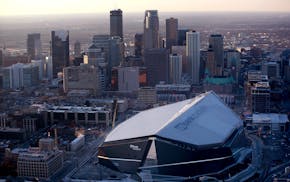Graco shocked Minneapolis when the manufacturer announced plans to leave the city's northeast riverfront last month, but it was no surprise where the company's new headquarters would be.
The northwest suburbs.
Specifically, Rogers or Dayton, as Graco has already set down roots on that edge of the Twin Cities metro area. And the company will have plenty of neighbors, as millions of square feet of new manufacturing and warehousing space has come online in recent years.
With ample land, nearby workers and crucial transportation links, this growing corner of the metro has become a manufacturing magnet.
"We're fortunate we haven't had to chase development," said Dayton's community development director, Jon Sevald. "It's come to us."
Point in case, a developer opened a million-square-foot industrial building in Dayton last year without lining up any tenants beforehand — the largest such speculative investment in the state. Earlier this year States Manufacturing started moving into half of the building, called the Cubes at French Lake.
"We have a lot of interest in industrial spec buildings, but there's a lot of competition out there," Sevald said.
Some of that competition comes from Dayton's nearby rivals.
Last month, solar panel-maker Heliene cut the ribbon on a massive new plant in Rogers that will create hundreds of jobs. That's on top of a relatively new Bobcat assembly plant and a plastic-recycling facility.
"There are definitely some big companies moving to Rogers, and we're loving it," said the city's mayor, Shannon Klick. "One of our highest priorities is to be business-friendly."
Both Dayton and Rogers officials said they welcome developments in either city.
"I would say it's friendly competition," said Brett Angell, community development director in Rogers. "You have to have a regional perspective. We want to see our neighboring communities do well and have success in projects, and we want to see that happen here, too."
The area is a sweet spot for workforce, capable of pulling in folks from inside the metro or farther outstate, officials said. Along I-94 and other major roads, the Rogers/Dayton corridor is primed for distribution. And perhaps most importantly, there's space to build.
Oppidan plans to construct a new 200,000-square-foot industrial building in Dayton without a planned tenant. Building "on spec" like that requires a high level of confidence the space will fill sooner than later.
In Anoka, nVent recently expanded its campus to make more liquid-cooling products for data centers. The company opened a distribution center in Dayton to make that expansion possible.
"Logistically, can we get the product out onto the major highways?" said Jesse Sanchez, vice president of integrated supply chain at nVent. "Dayton just has the infrastructure to move the product out."
The Dayton Parkway interchange at I-94, which opened in 2021, has been a crucial part of the city's manufacturing investments.
"The ability to be on the freeway in less than five minutes is extremely beneficial for all these manufacturers and businesses in general," said Dayton City Manager Zach Doud. "You've got to think of all the stuff that has developed since that interchange went in."
Closer suburbs like Brooklyn Park and Maple Grove still have industrial land with highway access and continue to attract major investments, like the Boston Scientific expansion that is pulling workers from Minnetonka. Competing with those major manufacturing markets means embracing being right on the edge of everything.
"We're the metro, but we're not the metro," Doud said. "You can get in town and out of town quickly if you need to."
Anoka, even as built-out as it is, also remains a hot spot for manufacturers, including Graco.
"This part of the metro area has always had a strong history of manufacturing," said Doug Borglund, community development director in Anoka. "It's really about making an effort to jump in and help them out, whatever we can do."
Heliene's CEO, Martin Pochtaruk, said $2.3 million in "visionary monetary support" from the state helped land the Canadian company's second Minnesota plant in Rogers.
"Minnesotans are welcoming," Pochtaruk said. "That attitude is generally called Minnesota Nice, and it's true. It is a thing, and that's how we are feeling in this new-to-us community of Rogers."
City staff are the ones typically submitting state funding applications and handling the money on a pass-through basis.
"Those applications are pretty intensive and a lot of work. ... That's something the city has been very supportive of doing," Angell said.
Klick recognized the "double-edged sword" of all this development — industrial and residential — and the new traffic it brings. The mayor said Rogers wants to find "balance" by reaping the rewards of growth, like a new brewery, splash pad and indoor-turf facility.
"Sometimes it's hard for the community, but you can see we're winning new things alongside those growing pains," Klick said.
In Dayton, the rapid industrial and residential growth has longtime residents accusing the city of "forcing" development; officials say they merely foster development through planning.
When construction crews raised the Cubes project atop a former golf course in Dayton, grievances also built up, said community development director Sevald.
"The amount of complaints has stopped since it was completed," he said. "But it's still a big change. There are people who bought homes next to farmland."
Patrick Kennedy and Walker Orenstein of the Minnesota Star Tribune contributed to this story.

Judge approves $69M class action settlement in UnitedHealth 401(k) litigation

Is your employer on the 2025 list of Minnesota's Top Workplaces?
Edina's Southdale Center opens dedicated wing for luxury stores

